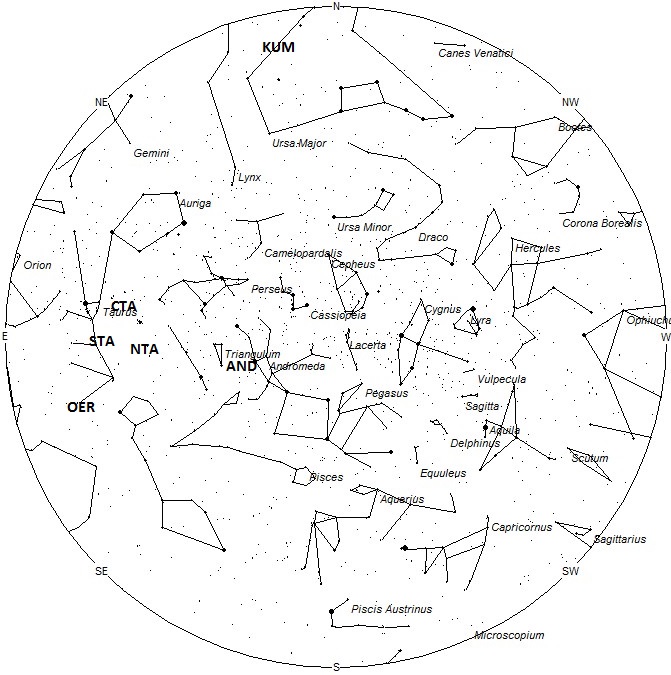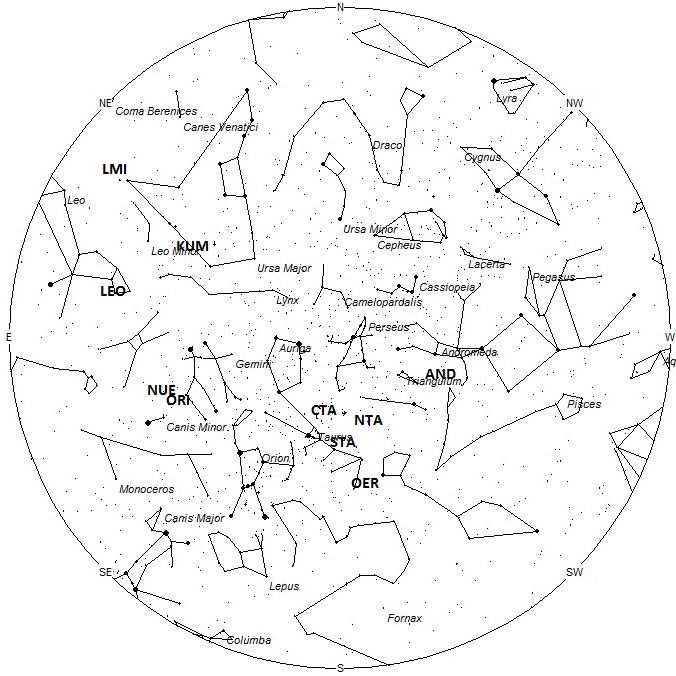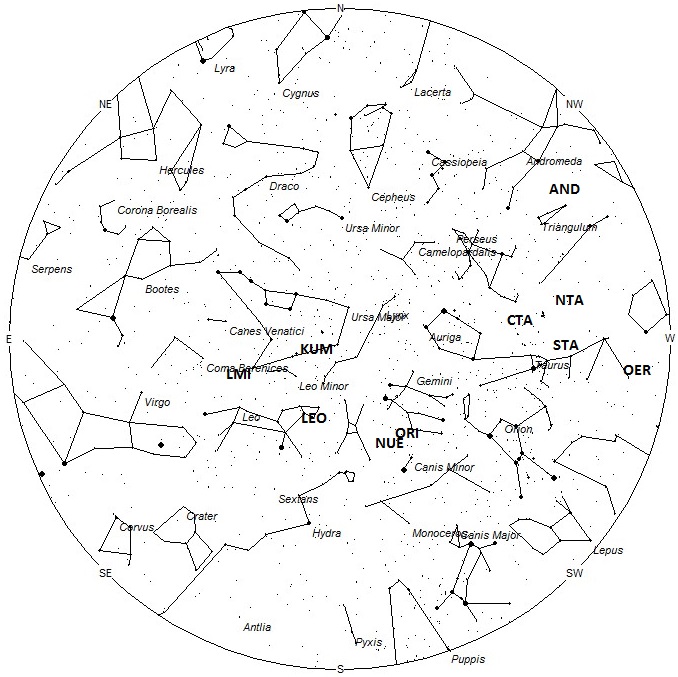As seen from the northern hemisphere, meteor rates continue to be strong in November. While no major activity is expected this month, the two Taurid radiants plus the Leonids keep the skies active. The addition of strong sporadic rates make November one of the better months to view meteor activity from north of the equator. Skies are fairly quiet as seen from the southern hemisphere this month. Activity from the three showers mentioned above may be seen from south of the equator, but the sporadic rates are much lower than those seen in the northern hemisphere.
During this period the moon will reach its new phase on Wednesday November 7th. At this time the moon will be located near the sun and will be invisible at night. This weekend the waning crescent moon will rise during the early morning hours but will not cause any problems viewing meteors as long as you keep it out of your field of view. The estimated total hourly meteor rates for evening observers this week is near 4 for those viewing from the northern hemisphere and 3 for those located south of the equator. For morning observers the estimated total hourly rates should be near 24 as seen from mid-northern latitudes and 18 from the southern tropics. The actual rates will also depend on factors such as personal light and motion perception, local weather conditions, alertness and experience in watching meteor activity. Note that the hourly rates listed below are estimates as viewed from dark sky sites away from urban light sources. Observers viewing from urban areas will see less activity as only the brighter meteors will be visible from such locations.
The radiant (the area of the sky where meteors appear to shoot from) positions and rates listed below are exact for Saturday night/Sunday morning November 3/4. These positions do not change greatly day to day so the listed coordinates may be used during this entire period. Most star atlases (available at science stores and planetariums) will provide maps with grid lines of the celestial coordinates so that you may find out exactly where these positions are located in the sky. A planisphere or computer planetarium program is also useful in showing the sky at any time of night on any date of the year. Activity from each radiant is best seen when it is positioned highest in the sky, either due north or south along the meridian, depending on your latitude. It must be remembered that meteor activity is rarely seen at the radiant position. Rather they shoot outwards from the radiant so it is best to center your field of view so that the radiant lies at the edge and not the center. Viewing there will allow you to easily trace the path of each meteor back to the radiant (if it is a shower member) or in another direction if it is a sporadic. Meteor activity is not seen from radiants that are located far below the horizon. The positions below are listed in a west to east manner in order of right ascension (celestial longitude). The positions listed first are located further west therefore are accessible earlier in the night while those listed further down the list rise later in the night.
These sources of meteoric activity are expected to be active this week.
The Andromedids (AND) reach maximum activity on November 5th. At that time the radiant will be located near 01:23 (021) +28 . This position lies on the border of Triangulum and Pisces, 4 degrees southwest of the 3rd magnitude star known as Mothallah (Alpha Trianguli). This part of the sky is best placed near 2200 Local Standard Time (LST), when the radiant lies highest above the horizon. This is a famous shower that produced some brilliant displays during the 19th century. Since then the main orbit of the particles from comet 3D/Biela have moved away from the Earth. Still, remnants may be seen from October 26 through November 17. Current rates would most likely be near 1 per hour as seen from the northern hemisphere and less than 1 as seen south of the equator. With an entry velocity of 19 km/sec., the average Andromedid meteor would be of very slow velocity.
The Northern Taurids (NTA) are active from a large radiant located near 03:24 (051) +21. This position lies in eastern Aries, 3 degrees northeast of the 4th magnitude star known as Botein (delta Arietis). Rates at this time should be near 5 per hour as seen from the northern hemisphere and 4 as seen south of the equator. Like its southern counterpart, these meteors may be seen all night long but the radiant is best placed near midnight LST when it lies on the meridian and is located highest in the sky. With an entry velocity of 28 km/sec., the average Northern Taurid meteor would be of slow velocity.
The Southern Taurids (STA) are also active from a large radiant centered near 03:36 (054) +14. This position lies in western Taurus, 10 degrees southwest of the Pleiades. These meteors may be seen all night long but the radiant is best placed near midnight LST when it lies on the meridian and is located highest in the sky. Rates at this time should be near 4 per hour regardless of your location. With an entry velocity of 29 km/sec., the average Southern Taurid meteor would be of slow velocity.
The omicron Eridanids (OER) were discovered by Japanese observers using video data from SonotoCo in 2007-2008. The activity period ranges from October 16 – November 24 with maximum activity occurring on November 4th. This is a weak shower that usually produces rates less than 1 per hour, even at maximum activity. The radiant is currently located at 03:36 (054) -02, which places it in northwestern Eridanus 10 degrees southeast of the 3rd magnitude star known as Menkar (alpha Ceti). This location is close to the source of the Southern Taurids so care must be taken to separate these meteors. Like the STA’s these meteors may be seen all night long but the radiant is best placed near 0100 LST when it lies on the meridian and is located highest in the sky. With an entry velocity of 29 km/sec., the average omicron Eridanid meteor would be of slow velocity.
The chi Taurids (CTA) were discovered by Dr. Peter Brown during his 7 year survey using the Canadian Meteor Orbit Radar (CMOR). This source is active from October 20 through November 17 with a maximum occurring near November 3rd. Current rates should be near 1 per hour as seen from the northern hemisphere and less than 1 as seen from south of the equator. The radiant is currently located at 04:16 (064) +26, which places it in western Taurus , 5 degrees east of the famous naked eye open cluster known as the Pleiades. This location is close to the source of the Northern Taurids so care must be taken to separate these meteors. These meteors may be seen all night long but the radiant is best placed near 0200 LST when it lies on the meridian and is located highest in the sky. With an entry velocity of 41 km/sec., the average chi Taurid meteor would be of medium velocity.
The Orionids (ORI) are still active from a radiant located at 07:17 (109) +15. This area of the sky lies in southern Gemini, 2 degrees south of the 4th magnitude star known as lambda Geminorum. This area of the sky is best placed near 0400 LST, when it lies highest above the horizon. Rates should be near 3 per hour no matter your location. With an entry velocity of 67 km/sec., most activity from this radiant would be of swift speed.
The nu Eridanids (NUE) were co-discovered by Japanese observers using SonotoCo and Juergen Rendtel and Sirko Molau of the IMO. Activity from this long-period stream stretches from August 23 all the way to November 16. A very shallow maximum occurred near September 24. The radiant currently lies at 07:44 (116) +14, which places it on the Gemini/Canis Minoir border, 9 degrees north of the zero magnitude star known as Procyon (alpha Canis Minoris). This area of the sky is best seen during the last dark hour before dawn when the radiant lies highest in a dark sky. Current rates are expected to be less than 1 per hour during this period no matter your location. With an entry velocity of 67 km/sec., the average meteor from this source would be of swift velocity. Some experts feel that these meteors are related to the Orionid shower, which peaked on October 22.
The first Leonids (LEO) of the season should begin appearing this weekend from a radiant located at located at 09:24 (141) +27. This position lies in northwestern Leo, just east of the 4th magnitude star known as Al Min’ħar al A’sad (kappa Leonis). Current rates are expected to be near 1 shower member per hour during the late morning hours as seen from the northern hemisphere. Hourly rates from south of the equator would be less than 1. Maximum is predicted to occur on November 17. The Leonid radiant is best placed during the last hour before morning twilight when the radiant lies highest in a dark sky. Leonids may be seen from the southern hemisphere but the viewing conditions are not quite as favorable as those north of the equator. With an entry velocity of 70 km/sec., most activity from this radiant would be of swift speed with numerous persistent trains on the brighter meteors.
The kappa Ursae Majorids (KUM) were discovered by cameras of the SonotaCo network in Japan during an outburst of activity on November 5, 2009. This radiant is active from November 3-10 with maximum activity occurring on the 7th. At maximum the radiant is located at 09:49 (147) +45. This position lies in southeastern Ursa Majoris, 7 degrees southeast of the 3rd magnitude star known as theta Ursae Majoris. Rates, even at maximum, are expected to be less than 1 regardless of your location. These meteors are best seen during the last hour before dawn when the radiant lies highest above the horizon in a dark sky. With an entry velocity of 66 km/sec., the average Kappa Ursae Majorid meteor would be of swift velocity.
The last of the Leonis Minorids (LMI) are expected this week. These meteors are active from October 12-Nov 5 with maximum activity occurring on October 22nd. This radiant is currently located at 11:32 (173) +32, which places it in southern Ursae Majoris, 2 degrees southeast of the 3rd magnitude star known as Alula Borealis (nu Ursae Majoris). The radiant is best placed just before dawn when it lies highest in a dark sky. This shower is better situated for observers situated in the northern hemisphere where the radiant rises far higher into the sky before the start of morning twilight. Current rates would be less than 1 no matter your location. At 62km/sec., the average Leonis Minorid is swift. From my personal experience this minor shower produces a high proportion of bright meteors.
As seen from the mid-northern hemisphere (45N) one would expect to see approximately 10 sporadic meteors per hour during the last hour before dawn as seen from rural observing sites. Evening rates would be near 3 per hour. As seen from the tropical southern latitudes (25S), morning rates would be near 7 per hour as seen from rural observing sites and 2 per hour during the evening hours. Locations between these two extremes would see activity between the listed figures.
The table below presents a list of radiants that are expected to be active this week. Rates and positions are exact for Saturday night/Sunday morning except where noted in the shower descriptions.
| SHOWER | DATE OF MAXIMUM ACTIVITY | CELESTIAL POSITION | ENTRY VELOCITY | CULMINATION | HOURLY RATE | CLASS |
| RA (RA in Deg.) DEC | Km/Sec | Local Standard Time | North-South | |||
| Andromedids (AND) | Nov 05 | 01:23 (021) +28 | 18 | 22:00 | 1 – <1 | III |
| Northern Taurids (NTA) | Nov 02 | 03:24 (051) +21 | 28 | 00:00 | 5 – 4 | II |
| Southern Taurids (STA) | Oct 29-Nov 03 | 03:36 (054) +14 | 27 | 00:00 | 4 – 4 | II |
| omicron Eridanids (OER) | Nov 04 | 03:36 (054) -02 | 29 | 00:00 | <1 – <1 | IV |
| chi Taurids (CTA) | Nov 03 | 04:16 (064) +26 | 41 | 01:00 | 1 – <1 | IV |
| Orionids (ORI) | Oct 22 | 07:17 (109) +15 | 67 | 04:00 | 3 – 3 | I |
| nu Eridanids (NUE) | Sep 24 | 07:44 (116) +14 | 67 | 04:00 | <1 – <1 | IV |
| Leonids (LEO) | Nov 17 | 09:24 (141) +27 | 70 | 07:00 | <1 – <1 | I |
| kappa Ursae Majorids (KUM) | Nov 07 | 09:49 (147) +45 | 66 | 07:00 | <1 – <1 | IV |
| Leonis Minorids (LMI) | Oct 22 | 11:32 (173) +32 | 62 | 09:00 | <1 – <1 | II |




